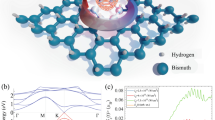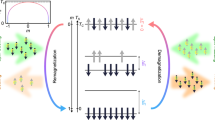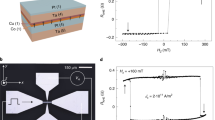Abstract
The demand for ever-increasing density of information storage and speed of manipulation has triggered an intense search for ways to control the magnetization of a medium by means other than magnetic fields1,2,3,4,5. Recent experiments on laser-induced demagnetization6,7,8 and spin reorientation9 use ultrafast lasers as a means to manipulate magnetization, accessing timescales of a picosecond or less. However, in all these cases the observed magnetic excitation is the result of optical absorption followed by a rapid temperature increase. This thermal origin of spin excitation considerably limits potential applications because the repetition frequency is limited by the cooling time10. Here we demonstrate that circularly polarized femtosecond laser pulses can be used to non-thermally excite and coherently control the spin dynamics in magnets by way of the inverse Faraday effect. Such a photomagnetic interaction is instantaneous and is limited in time by the pulse width (∼200 fs in our experiment). Our finding thus reveals an alternative mechanism of ultrafast coherent spin control, and offers prospects for applications of ultrafast lasers in magnetic devices.
This is a preview of subscription content, access via your institution
Access options
Subscribe to this journal
Receive 51 print issues and online access
$199.00 per year
only $3.90 per issue
Buy this article
- Purchase on Springer Link
- Instant access to full article PDF
Prices may be subject to local taxes which are calculated during checkout



Similar content being viewed by others
References
Asamitsu, A., Tomioka, Y., Kuwahara, H. & Tokura, Y. Current switching of resistive states in magnetoresistive manganites. Nature 388, 50–52 (1997)
Ohno, H. et al. Electric-field control of ferromagnetism. Nature 408, 944–946 (2000)
Kato, Y., Myers, R. C., Gossard, A. C. & Awschalom, D. D. Coherent spin manipulation without magnetic fields in strained semiconductors. Nature 427, 50–53 (2004)
Yamanouchi, M., Chiba, D., Matsukura, F. & Ohno, H. Current-induced domain-wall switching in a ferromagnetic semiconductor structure. Nature 428, 539–542 (2004)
Lottermoser, Th. et al. Magnetic phase control by an electric field. Nature 430, 541–544 (2004)
Beaurepaire, E., Merle, J.-C., Daunois, A. & Bigot, J.-Y. Ultrafast spin dynamics in ferromagnetic nickel. Phys. Rev. Lett. 76, 4250–4253 (1996)
Hohlfeld, J., Matthias, E., Knorren, R. & Bennemann, K. H. Nonequilibrium magnetization dynamics of nickel. Phys. Rev. Lett. 78, 4861–4864 (1997)
Koopmans, B., van Kampen, M., Kohlhepp, J. T. & de Jonge, W. J. M. Ultrafast magneto-optics in nickel: magnetism or optics? Phys. Rev. Lett. 85, 844–847 (2000)
Kimel, A. V., Kirilyuk, A., Tsvetkov, A., Pisarev, R. V. & Rasing, Th. Laser-induced ultrafast spin reorientation in the antiferromagnet TmFeO3 . Nature 429, 850–853 (2004)
Hohlfeld, J. et al. Fast magnetization reversal of GdFeCo induced by femtosecond laser pulses. Phys. Rev. B 65, 012413 (2002)
Faraday, M. On the magnetization of light and the illumination of magnetic lines of force. Phil. Trans. R. Soc. Lond. 136, 104–123 (1846)
Landau, L. D. & Lifshitz, E. M. Electrodynamics of Continuous Media (Pergamon, Oxford, 1984)
Pitaevskii, L. P. Electric forces in a transparent dispersive medium. Sov. Phys. JETP 12, 1008–1013 (1961)
van der Ziel, J. P., Pershan, P. S. & Malmstrom, L. D. Optically-induced magnetization resulting from the inverse Faraday effect. Phys. Rev. Lett. 15, 190–193 (1965)
Pershan, P. S., van der Ziel, J. P. & Malmstrom, L. D. Theoretical discussion of inverse Faraday effect, Raman scattering and related phenomena. Phys. Rev. 143, 574–583 (1966)
Awschalom, D. D., Warnock, J. & von Molnar, S. Low-temperature magnetic spectroscopy of a dilute magnetic semiconductor. Phys. Rev. Lett. 58, 812–815 (1987)
Shen, Y. R. & Bloembergen, N. Interaction between light waves and spin waves. Phys. Rev. 143, 372–384 (1960)
Gomez-Abal, R., Ney, O., Satitkovitchai, K. & Hübner, W. All-optical subpicosecond magnetic switching in NiO(001). Phys. Rev. Lett. 92, 227402 (2004)
Wijn, H. P. J. (ed.) Numerical Data and Functional Relationships. In Landolt-Börnstein New Series Group III, Vol. 27, f3, 125–134 (Springer, Berlin, 1981)
Dzyaloshinskii, I. E. Thermodynamic theory of weak ferromagnetism in antiferromagnetic substances. Sov. Phys. JETP 5, 1259–1272 (1957)
Moriya, T. Anisotropic superexchange interaction and weak ferromagnetism. Phys. Rev. 120, 91–98 (1960)
Zvezdin, A. K. & Kotov, V. A. Modern Magnetooptics and Magnetooptical Materials (IOP, Bristol, 1997)
White, R. M., Nemanich, R. J. & Herring, C. Light scattering from magnetic excitations in orthoferrites. Phys. Rev. B 25, 1822–1836 (1982)
Balbashov, A. M., Volkov, A. A., Lebedev, S. P., Mukhin, A. A. & Prokhorov, A. S. High-frequency magnetic properties of dysprosium orthoferrite. Sov. Phys. JETP 61, 573–586 (1985)
Koshizuka, N. & Hayashi, K. Raman scattering from magnon excitations in RFeO3 . J. Phys. Soc. Jpn 57, 4418–4428 (1988)
Keller, U. Recent developments in compact ultrafast lasers. Nature 424, 831–838 (2003)
Acknowledgements
We thank V. N. Gridnev for discussions, and T. Toonen and A. van Etteger for help with measurements. This work was partially supported by the European IST network SPINOSA, the RTN network DYNAMICS, the Russian Foundation for Basic Research (RFBR), de Nederlandse Organisatie voor Wetenschappelijk Onderzoek (NWO), and de Stichting voor Fundamenteel Onderzoek der Materie (FOM).
Author information
Authors and Affiliations
Corresponding author
Ethics declarations
Competing interests
Reprints and permissions information is available at npg.nature.com/reprintsandpermissions. The authors declare no competing financial interests.
Rights and permissions
About this article
Cite this article
Kimel, A., Kirilyuk, A., Usachev, P. et al. Ultrafast non-thermal control of magnetization by instantaneous photomagnetic pulses. Nature 435, 655–657 (2005). https://doi.org/10.1038/nature03564
Received:
Accepted:
Published:
Issue Date:
DOI: https://doi.org/10.1038/nature03564
This article is cited by
-
Light control with Weyl semimetals
eLight (2023)
-
Strong transient magnetic fields induced by THz-driven plasmons in graphene disks
Nature Communications (2023)
-
Timescales and contribution of heating and helicity effect in helicity-dependent all-optical switching
Rare Metals (2023)
-
Recent development of E-field control of interfacial magnetism in multiferroic heterostructures
Nano Research (2023)
-
Structural Phase Transformation, Magnetic and Optical Properties of Ho3+ Substituted BiFeO3 Nanoparticles
Journal of Superconductivity and Novel Magnetism (2023)
Comments
By submitting a comment you agree to abide by our Terms and Community Guidelines. If you find something abusive or that does not comply with our terms or guidelines please flag it as inappropriate.



